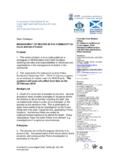Transcription of Proposition 65 FAQ - Decal Craft
1 Frequently Asked Questions Regarding California Proposition 65. and Allegations of Lead and Cadmium Exposure from Outside Surfaces of Glass and Ceramicware By: James A. Calderwood, General Counsel Andrew Bopp, Public Affairs Director Society of Glass and Ceramic Decorators This summary of Frequently Asked Questions regarding California's Proposition 65 is intended to provide broad general answers to some frequent questions regarding Proposition 65 and allegations of lead exposure from glass and ceramicware. For details, you and your legal counsel are advised to review the actual settlement documents referred to below. For a copy of the August 18, 2005 settlement as approved by the court, SGCD members are invited to contact Andy Bopp at This summary is for informational purposes only, and you should consult with your own legal counsel to review your particular situation and what actions you should take. 1. What is Proposition 65 in California? California's Safe Drinking Water and Toxic Enforcement Act of 1986 ( Proposition 65).
2 Requires warnings to consumers if a product exposes consumers to a wide variety of chemicals including lead and cadmium. California's Office of Environmental Health Hazard Assessment (OEHHA) has established the maximum daily exposure levels for each chemical beyond which a consumer warning is required. Proposition 65 does not ban any product; it simply requires warnings. Proposition 65 applies only in California, and it covers all products distributed in the state. 2. Who can act to enforce Proposition 65 requirements? Legal proceedings to enforce Proposition 65 may be instituted by the State of California or private citizens. If a private citizen is successful in such an action, he or she can receive monetary awards and attorneys fees. There have been thousands of such suits since 1986. 3. What is a Proposition 65 60-day Notice of Violation? A California Proposition 65 60-Day Notice of Violation is a legal document that is served by a plaintiff to a defendant alleging violations of Proposition 65 warning requirements.
3 During the 60-day notice period, the California Attorney General's office can review the allegations and take over the proceedings at its discretion. At the end of the 60-day period, either a private plaintiff or the State of California can initiate legal proceedings against the defendant. 4. Can a plaintiff allege a Proposition 65 violation without alleging that someone has been harmed by the product in question or that the product violates some safety standard? Copyright 2006 Society of Glass and Ceramic Decorators 1. Proposition 65 does not require a plaintiff to allege that anyone has been harmed by the product in question. It also does not require the plaintiff to allege that the product is defective or that it violates an existing federal or state safety standard. 5. What is a Proposition 65 Warning? A Proposition 65 warning is a notice that warns the consumer in California that a product in question may expose the consumer to any one of the hundreds of chemicals that are known by the State of California to cause cancer and/or birth defects.
4 Warning language and methods are included in many Proposition 65 settlements. You are advised to review such settlements and consult with an attorney before determining if or how you will provide Proposition 65 warnings in California. 6. What should you do if you receive a Proposition 65 60-day Notice of Violation? You should contact a lawyer who is familiar with the Proposition 65 process in California. Questions of liability may arise including between various companies in the supply chain. It is advisable to seek counsel with expertise in Proposition 65 matters when dealing with Proposition 65 allegations. 7. What are the Proposition 65 standards for tableware food contact surfaces? In 1993, a settlement was reached between the State of California and a majority of defendants to resolve a 1991 suit alleging lead exposure from the food contact surfaces of ceramic dinnerware. There were no allegations in the suit that any products leached lead in excess of certain standards established by the Food and Drug Administration (FDA) or that anyone was harmed by the products.
5 This settlement established safe harbor thresholds, and these can be considered the current standards California enforcement officials expect for the food contact surfaces of ceramic foodware. Cadmium thresholds for the food contact surfaces of tableware were established in 1998. after that metal was added to the Proposition 65 list of chemicals that could require an exposure warning. For more detail, you are encouraged to examine SGCD's White Paper and the entire 1993. settlement document. SGCD members may contact Andy Bopp for a copy of either document. 8. Why is Proposition 65 an issue for the glass and ceramic industry now? In 2001, a private plaintiff (not the State of California) initiated the first of hundreds of Proposition 65 allegations related to alleged exposure to lead, and later cadmium, from the outside non-food-contact surfaces of glass and ceramicware. The first case was settled in 2002 and various other allegations were resolved in 2003 and 2004. During this time, SGCD worked with counsel for various defendants and the California Attorney General's office to develop a test protocol to determine exposure from the outside non- Copyright 2006 Society of Glass and Ceramic Decorators 2.
6 Lip/rim surface of drinkware. The Attorney General's office, however, decided not to go forward with a resolution of the allegations. SGCD was not a party to any of the settlements which are binding only on the signing parties. No party was found by the court to have violated Proposition 65, and each maintained that no violation occurred. No allegations were made of actual harm to anyone from the ware in question. 9. What is the Opt-in Settlement of August 18, 2005? On August 18, 2005, a California Superior Court in San Francisco approved still another settlement between a distributor of glass and ceramicware and a private plaintiff regarding California Proposition 65 allegations related to lead and cadmium exposure and the non-food contact and lip/rim surfaces of glass and ceramicware. The settlement includes provisions allowing other parties to opt-in to the settlement for a limited time by agreeing to the terms of the settlement and paying fees consisting of civil penalties, plaintiff's attorneys' fees and settlement related costs.
7 The settlement provides for varying monetary fees based on the type and size of the settling opt-in party. It also limits a party's option to warn. See the settlement document for details. 10. Are products such as figurines, vases and other non-food items covered by the August 18, 2005 settlement? This settlement includes restrictions on the use of both lead and cadmium bearing colors and the outside non-lip/rim surface of glass and ceramic tableware as well as for glass and ceramic ware that is not for use with food or beverages including figurines, decorative tiles and other products. See the settlement document for details. 11. Does the August 18, 2005 settlement include provisions affecting decorating methods? In addition to monetary penalties and attorneys' fees, the defendant and plaintiff in the opt-in settlement agreed to reformulation requirements regarding the decoration of covered ware. The settlement includes a provision for warnings as well as a provision whereby the defendant agrees to reformulate at least 80 percent of covered ware manufactured after December 31, 2006 while undertaking all commercially reasonable efforts to sell 100 percent reformulated products after that date in California.
8 This may limit their ability in the future to select the warning method of Proposition 65. compliance. 12. Is there an official Proposition 65 standard for glass and ceramicware? The August 18, 2005 settlement is legally binding only on the parties to the agreement, and it only applies in California. It is not related to FDA's mandatory lead and cadmium release standards or to the lip and rim release standards monitored by FDA. The settlement also does not preclude the plaintiff or anyone else from pursuing similar or Copyright 2006 Society of Glass and Ceramic Decorators 3. related allegations against any other retailer, distributor or manufacturer of ware in California. As noted, the provisions of the settlement are not binding on any other party; however, companies should consider the possibility that allegations could be made at any time relating to ware distributed in California. By meeting the standards agreed to by the settling parties, it could assist a company in establishing a defense based on a claim that the ware in question would not require a warning.
9 Such a defense would be made through the Proposition 65 legal process. We encourage members of the industry to consult with their own legal counsel to ascertain their particular method of compliance and the impact of adhering to any settlement or other legal action. 13. Can a Proposition 65 warning be attached to a package or product? The August 18, 2005 and other settlements stipulate that a warning can be applied to the packaging, labeling or directly to the product in question. There are also stipulations regarding placement of the warning on the package, label or product itself. See the settlement document, and consult with your counsel for full details. 14. Can warning requirements be satisfied by posting warnings at the point-of-sale? The August 18, 2005 and other settlements also stipulate that a defendant can execute its warning obligations by posting signs at retail in California where the product is sold. The settlement also establishes specific warning language and methods for identifying what specific ware in the store is covered by the warning.
10 See the settlement document, and consult with your counsel for full details. 15. Is there an obligation to post warnings for products sold via catalogs and website sales venues? The August 18, 2005 and other settlements also stipulate that the settling defendant place warnings if required in mail-order catalogs sent to California addresses or on websites offering items for sale in California or with the product when it is shipped to California. The settlement contains details regarding where the warning notice must be placed in a catalog and on a website. It also contains details regarding warnings that are provided as a package insert or label. See the settlement document, and consult with your counsel for full details. 16. Does Proposition 65 affect ware used in bars, restaurants and other food service entities? The August 18, 2005 and other settlements also stipulate how a settling defendant that is a restaurant, bar, amusement or recreation establishment that distributes, serves or sells food or beverages can satisfy warning obligations.






